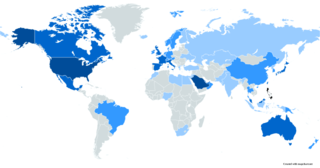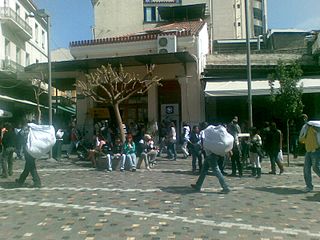
Demographic features of the population of Denmark include ethnicity, education level, health of the populace, economic status, religious affiliations, and other aspects.

Demographic features of the population of Italy include population density, ethnicity, education level, health of the populace, economic status, religious affiliations and other aspects.

A migrant worker is a person who migrates within a home country or outside it to pursue work. Migrant workers usually do not have an intention to stay permanently in the country or region in which they work.

An Overseas Filipino is a person of full or partial Filipino origin who trace their ancestry back to the Philippines but are living and working outside of the country. They get jobs in countries and they move to live in countries. This term generally applies to both people of Filipino ancestry and citizens abroad. As of 2019, there were over 12 million Filipinos overseas.

Romanians in Italy became a significant population after 1999, due to a large wave of emigration known in Romania as Fenomenul migrației către UE. A large part of Romanian emigrants went to Spain or Italy, whose national languages are Romance languages like Romanian. They were followed by another wave beginning in 2002, when Romanian citizens obtained the right to move to any Schengen Zone country without a visa. In 2007 Romania joined the European Union, further increasing the economic and political ties between the countries.
African emigrants to Italy include Italian citizens and residents originally from Africa. Immigrants from Africa officially residing in Italy in 2015 numbered about 1,000,000 residents. Afro-Italians (Afroitaliani) are born and are raised in Italy, citizen of African descent or of mixed African and Italian roots.

Religion in Italy has been historically characterized by the dominance of Catholicism since the Great Schism. According to a 2023 Ipsos survey, 61% of the country's residents are Catholic, 4% are Protestants, 3% other Christians, 28% are irreligious, 2% prefer not to say, 1% are Muslims, and 1% adhere to other religions. Italy's Catholic patron saints are Francis of Assisi and Catherine of Siena.

Immigration to Greece percentage of foreign populations in Greece is 7.1% in proportion to the total population of the country. Moreover, between 9 and 11% of the registered Greek labor force of 4.4 million are foreigners. Migrants additionally make up 25% of wage and salary earners.
The community of Chinese people in Italy has grown rapidly in the past ten years. Official statistics indicate there are at least 330,495 Chinese citizens in Italy, although these figures do not account for former Chinese citizens who have acquired Italian nationality or Italian-born people of Chinese descent.
Indians in Italy comprise the second largest population of Indians in Continental Europe, after Indians in Germany. Although Italy and India have maintained important relations since ancient times, significant Indian migration to Italy is a recent phenomenon. Many Indians began immigrating to Italy in the early 1990s, when the Italian government initiated programs to get Indian IT professionals and engineers to contribute to the technology sector in Italy. Most Indian immigrants came to Italy legally.

In 2021, Istat estimated that 5,171,894 foreign citizens lived in Italy, representing about 8.7% of the total population. These figures do not include naturalized foreign-born residents as well as illegal immigrants, the so-called clandestini, whose numbers, difficult to determine, are thought to be at least 670,000.
German Afghans are German citizens with Afghan ancestry and non-citizen residents born in, or with ancestors from, Afghanistan. It is the largest Afghan community in Europe and part of the worldwide Afghan diaspora, of which it is one of the largest. In 2022, the Federal Statistical Office of Germany estimated the number of people of Afghan descent residing in Germany at 425,000 the third largest from outside the EU, and the largest group from Asia excluding the Middle East and Caucusus. In particular, there are over 50,000 Afghans in Hamburg alone, comprising over 7% of the city's population. Offenbach am Main and Hamburg had the highest shares of Afghan migrants among all German districts in 2011. There were 51,000 people of Afghan decent living in Hamburg in 2023.
The Albanians in Italy refers to the Albanian migrants in Italy and their descendants. They mostly trace their origins to Albania, Greece and since recently to a lesser extent to Kosovo, North Macedonia and other Albanian-speaking territories in the Balkan Peninsula. As of 2019, there were 441,027 Albanian citizens living in Italy, one of the largest Albanian immigrant population in any country as well as the second largest immigrant group within Italy. They are adherents of different religions and are Catholics, Orthodox, Protestants, Sunnis and Bektashis as well as various forms of Irreligion. Between 2008 and 2020 more than 250,000 Albanians acquired Italian citizenship.
There is a large population of Moroccans in Italy. are Italians citizens and nationals ethnic group, of the Italy with Italian citizenship and an Italian passport of Moroccans descent, immigrants from Morocco to the Italy and their descendants they are the third largest ethnic group in the Italy after Romanians in Italy and Albanians in Italy. who come from various ethnic groups, form a distinct community in Italy and part of the wider Moroccan diaspora. They represent the largest non-Europeans immigrant population in Italy and are widely referred to as Italiano-Marocchini in Italians ,According to the Italian National Institute of Statistics, the country was home to 420,650 Moroccan immigrants in 2017. The equivalent figure in 2014 was 454,773.
Arabs in Europe are people of Arab descent living in Europe today and over the centuries. Several million Arabs are residents in Europe. The vast majority form part of what is sometimes called the "Arab diaspora", i.e. ethnic Arabs or people descended from such living outside the Arab World. Most of the Arabs in Europe today are from the Maghreb.
Women migrant workers from developing countries engage in paid employment in countries where they are not citizens. While women have traditionally been considered companions to their husbands in the migratory process, most adult migrant women today are employed in their own right. In 2017, of the 168 million migrant workers, over 68 million were women. The increase in proportion of women migrant workers since the early twentieth century is often referred to as the "feminization of migration".

Italy–Philippines relations are the interstate and bilateral relations between Italy and the Philippines. The bilateral relations between Italy and the Philippines was established on 9 July 1947.
Caregiving by country is the regional variation of caregiving practices as distinguished among countries.
Denmark has seen an increase in immigration over the past 30 years, with a large part of the immigrants originating from non-Western countries. As of 2014, more than 8 percent of the population of Denmark consists of immigrants. As of Q2 of 2022, the population of immigrants is 652,495, excluding Danish born descendants of immigrants to Denmark. This shift in demographics has posed challenges to the nation as it attempts to address cultural and religious differences, labour shortages, employment gaps, education of immigrants and their descendants, spatial segregation, crime rates and language abilities.
Taiwan, with a population of 23.58 million as of 2022, is home to around 750,000 foreign workers, commonly known as "外勞" or "wailao". Among them, around 230,000 are care workers, mainly from Southeast Asia. They represent 2% of the total workforce in Taiwan.
Дель Ґаудіо (Del Gaudio), С. 2023. Ukrainian Studies in Italy: present and future developments (Original title: “Україністика в Італії: сучасність і перспективи розвитку”). IV Міжнародна наукова конференція: Актуальні проблеми романо-германської філології. Матеріали міжнародної наукової конференції. Київ: Український державний університет імені Михайла Драгоманова, с.8-12.
 Christianity: 90.8%, of which Orthodox Christians 68%, Catholics 22.5% and Protestants 0.3%
Christianity: 90.8%, of which Orthodox Christians 68%, Catholics 22.5% and Protestants 0.3% Muslims: 0.1%
Muslims: 0.1%








